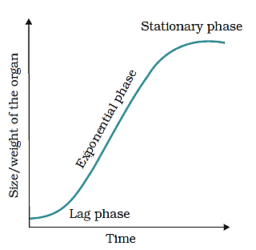1. Define growth, differentiation, development, dedifferentiation, development, redifferentiation, determinate growth, meristem and growth rate.
Solution:
Growth – it is an irreversible, permanent increase in the size of an organ or its parts or even of an individual cell. Growth is supplemented by metabolic activities taking place due to the energy.
Differentiation – The cells derived from root apical and shoot-apical meristems and cambium differentiate and mature to perform specific functions. This act leading to maturation is termed as differentiation.
Development – All the changes that an organisms goes through in its lifetime are called as development.
Dedifferentiation – Plants which has lost the capacity to divide can regain the capacity under certain conditions. This phenomenon is called as dedifferentiation. Example – meristem formation
Redifferentiation – Dedifferentiation produces cells that once again lose the capacity to divide but mature to perform specific functions are said to be redifferentiated.
Determinate growth – Ability of a cell, tissue or organism to grow for a certain period is called determinate growth. In most of the plants growth is indefinite, where some plants grow to a certain level and then stop growing.
Meristem – Plant tissue containing undifferentiated cells (meristematic cells) are called meristem.
Growth rate – Increase growth per unit time is called a growth rate.
2. Why is not anyone parameter good enough to demonstrate growth throughout the life of a flowering plant?
Solution:
Growth is a consequence of increase in the quantity of protoplasm. Measuring the protoplasmic growth includes several parameter, to name a few – increase in height, weight, number of cells, fresh tissue sample, length, area, volume etc. Hence it is difficult to demonstrate any one parameter of growth throughout the life of a flowering plant.
3. Describe briefly:
(a) Arithmetic growth
(b) Geometric growth
(c) Sigmoid growth curve
(d) Absolute and relative growth rates
Solution:
(a)In arithmetic growth, only one daughter cell continues to divide while the other differentiates and matures. The simplest expression of arithmetic growth is exemplified by a root elongating at a constant rate.

It can be mathematically expressed as follows:
Lt= LO+ rt
Lt= length of time ‘t’
LO= length at time ‘zero’
r= growth rate/elongation per unit time
(b)In geometric growth, the initial growth is slow (lag phase), and it increases rapidly after that – at an exponential rate (log or exponential phase). Here, both the progeny cells following mitotic cell division retain the ability to divide and continue to do so. The growth slows down due to limited nutrient supply leading to stationary phase. The number increases in a multiplicative pattern in geometric growth.

In geometric growth if we plot the parameter of growth against time, we get a typical sigmoid or S-curve.
Exponential growth can be expressed as:
W1= W0ert
W1= final size
W0= initial size of the period
r=growth rate
t=time growth
e=base of natural logarithms
‘r’ is the relative growth as well as the measure of the ability of plants to generate new plant substances which is termed as efficiency index. Thus, the final size of W1is dependant on the initial size W0
(c) Sigmoid growth curve
It is an S – shaped graph that is generated by plotting growth against time and has four main components – a slow lag phase, exponential phase or rapid phase, stage of diminishing growth and stationary phase.





